This blog provides a comprehensive review of the Fluke 116 Multimeter along with the theory behind multimeter usage and operation.
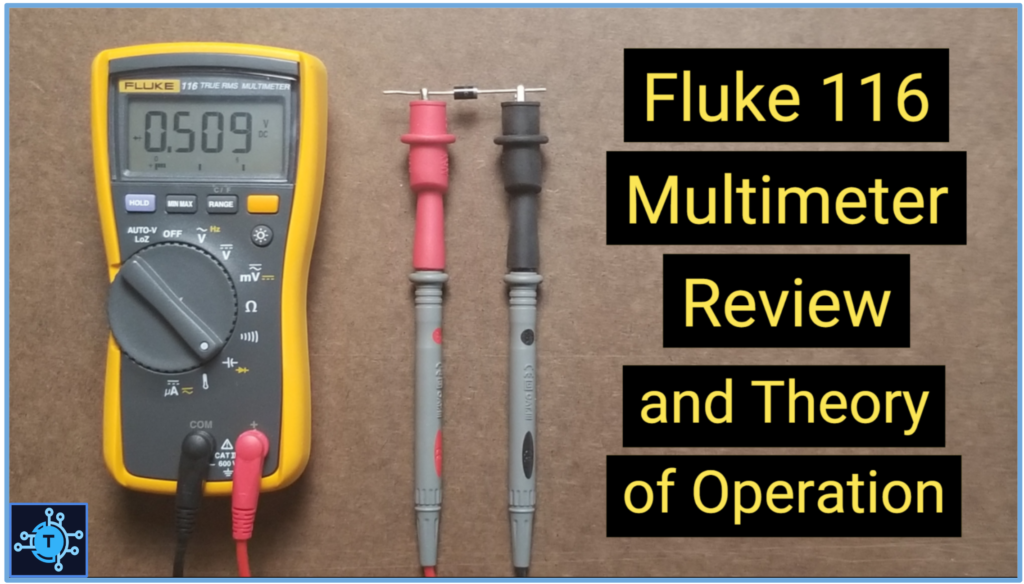
About the Fluke 116 Multimeter
The Fluke 116 digital multimeter was designed for Field Technicians. It has many functions that are relevant to HVAC, appliance repair, and other like disciplines. Here is a list of its measurement functions:
- DC Voltage from 0.001 V to 600 V
- DC Millivolt (mV) range from 0.1 mV to 600 mV
- AC Voltage from 0.06 V to 600 V
- AC Millivolt (mV) range from 6 mV to 600 mV
- True RMS AC Voltage Readings
- LoZ (Low Impedance) Voltage Mode for DC and AC (auto select)
- Resistance from 0.1 Ω to 40 MΩ
- Continuity Range if Resistance < 20 Ω
- Temperature Range from -40C to 400C (-40F to 752F)
- Diode/Semiconductor Test
- Capacitance from .001 uF to 9999 uF
- Frequency
- DC Current from 0.1 uA to 600 uA
- AC Current from 6 uA to 600 uA
- Backlight, Hold, Min/Max, and Range Functions
DC Voltage
Typical types of DC voltage sources are batteries and DC power supplies. So you would use this mode if you wanted to check the voltage across a battery, a DC voltage source on a control board in a appliance or HVAC system (such DC voltage sources are often 5V or 12V). Also any component on a circuit board that should have a DC voltage across or connected to it (with respect to ground), can be tested with this mode – provided that the DC voltage source is within the range of this meter.
DC Voltage Range: 0.001 V to 600 V
Stated Accuracy: 0.5% + 2 counts
Theory: DC (direct current) voltage is an electrical potential that does not oscillate. It causes current to flow in only one direction.
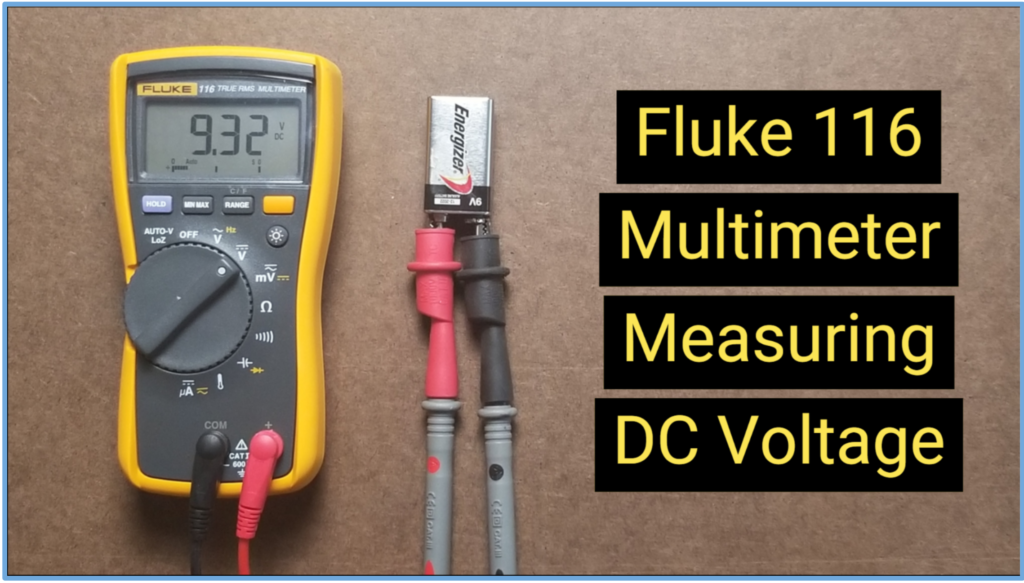
AC Voltage
AC voltage is supplied by power companies and is typically what you would measure in a residential outlet.
AC Voltage Range: 0.06 V to 600.0 V
Frequency range is from 5 Hz to 50 KHz.
Stated Accuracy: 1.0% + 3 counts
Theory: AC (alternating current) voltage differs from DC in that it changes direction at a rate determined by its frequency. Thus, it causes current to flow back and forth (or to oscillate) in a circuit. A common frequency in the US for household line voltage is 60Hz (cycles per second), which means that the current changes direction twice every 1/60th of a second.
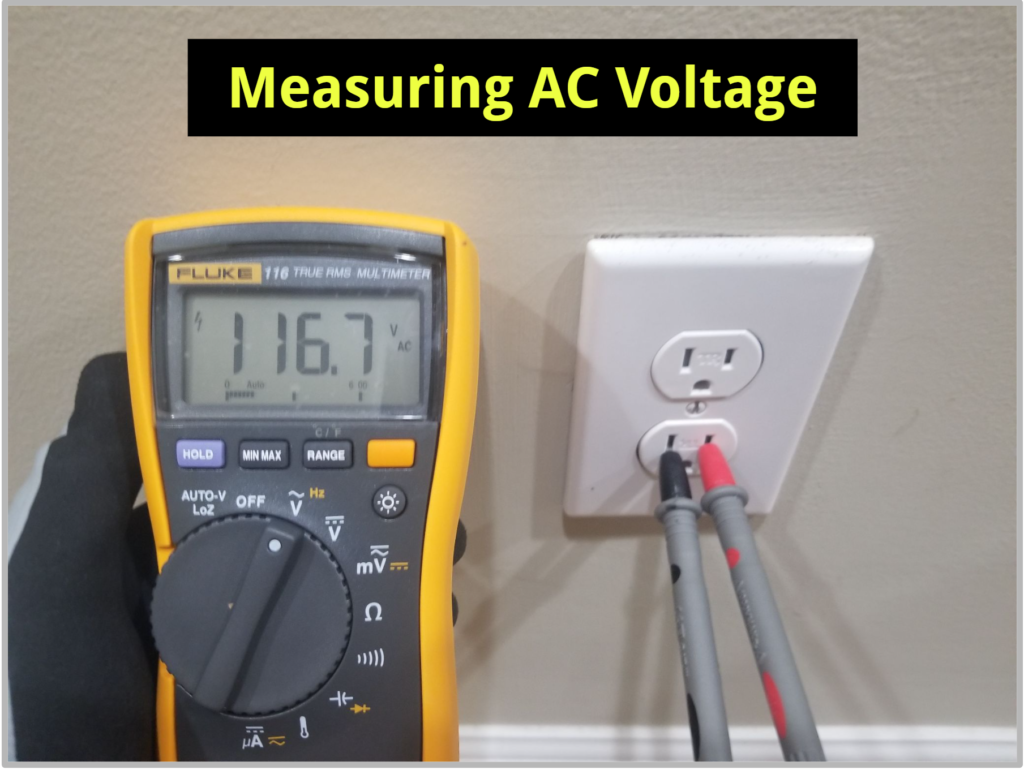
What is RMS?
The Fluke 116 is characterized as a “True RMS” meter.
Theory: RMS means “Root Mean Square”, which is a mathematical interpretation of the signal that is the equivalent to that of DC voltage in its ability to deliver the same amount of power to a resistive load. True RMS meters are designed to measure more complex waveforms (not just sinusoidal).
Matrix of RMS values of Sine, Square, Full-wave, and Half-wave Signals
Below is a matrix of how well the Fluke 116 fared while measuring certain types of non-sinusoidal waveforms as compared to a Klein CL800 true RMS, an Amprobe True RMS, an Amprobe standard AC meter, and a digital oscilloscope. Included in the matrix are the measured RMS values of 10 volt peak sinusoidal, square, full wave, and half wave rectified signals – all of which are waveforms shapes that field Technicians are likely to encounter.
| Meter | Sinusoidal | Square | Full-wave | Half-wave |
| Formula | =Vp/1.414 | =Vp | =Vp/1.414 | =Vp/2 |
| Calculated Value | 7.07v | 10.00 v | 7.07 v | 5.0 v |
| Sigilent 1104X-E scope | 7.09 v | 10.09 v | 7.33 v | 5.3 v |
| Fluke 116 | 7.03 v | 10.01 v | 3.07 v | 3.84 v |
| Klein CL800 | 7.03 v | 9.98 v v | 3.07 v | 3.85 v |
| Amprobe (true-RMS) | 7.06 v | 10.05 v | 3.07 v | 3.83 v |
| Amprobe (not true-RMS) | 6.98 v | 11.06 v | 2.93 v | 3.84 v |
LoZ
Using this mode puts a load on the circuit that you are testing. Normally the input impedance of the meter in the voltage testing mode is 10MΩ, which means that the circuit you are testing the voltage in will barely notice the meter. LoZ mode, however, puts a load on the circuit because it has an input impedance of approximately 3KΩ. So when checking for ghost voltages, compromised voltage sources, or voltages caused by current leakage, the LoZ mode tends to shut them down. For example, a voltage source such as a wall receptacle that has a loose connection upstream of it, the approximate 3KΩ impedance is low enough to drop the voltage noticeably (because it creates a voltage divider). So this feature can help detect ghost voltages which are those that are present in a circuit when they really shouldn’t be, or high-impedance voltage sources, which read normally with a traditional voltmeter, but fail under load. Please see my full article on LoZ benefits HERE.
Theory: LoZ stands for “low impedance”.
What Happens When you use LoZ on a Fluke 116 Multimeter?
Let’s take a look below at two scenarios for an electric dryer that ran, but had no heat. The first one is using the Fluke 116 on its standard AC voltage mode to read the circuit that has an upstream loose L2 in the order of 500 Ω. The second scenario is where you used the LowZ mode to measure it.
Theory: Both methods effectively use a “voltage divider” to give you a reading. A voltage divider is when two or more resistances (or impedances) in a series circuit split the voltage up in a way that adds up to the total circuit voltage. For example, if you have 240v across R1 and R2 in series, the sum of the voltage across them equals 240v.
The standard formula for the voltage divider is shown in the below image. It is used for both scenarios. As you can see, using the standard voltmeter mode essentially gives you 240v – so you’d not be the wiser of what’s going on in the circuit.
However, when you use the LowZ mode, the voltage divider becomes very useful. This is depicted in the 2nd scenario in the image. The voltage you read will be 205.74v. This immediately tells you something is weak with either L1 or L2. You can then use the LowZ function to test L1 to N or L2 to N to determine which line is weak. You may already intuitively know though, that since the dryer had no heat, the problem is likely on L2, because if it was on L1, the dryer likely would not have even started (the motor typically gets its voltage from L1 to N.
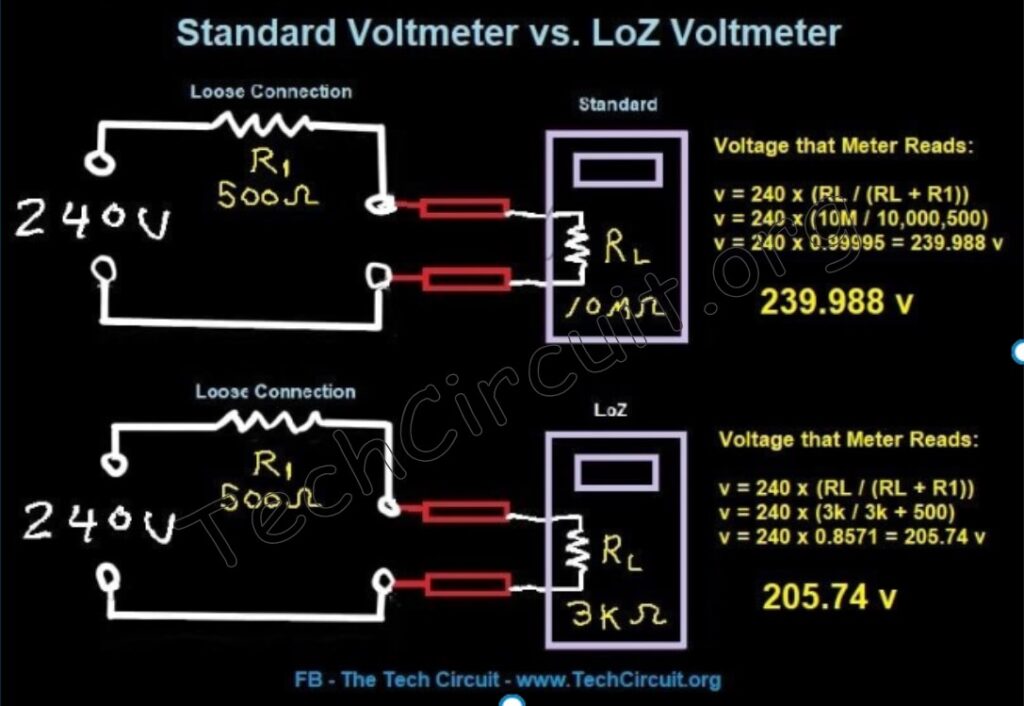
Click the Picture Below to Purchase the Fluke Multimeter
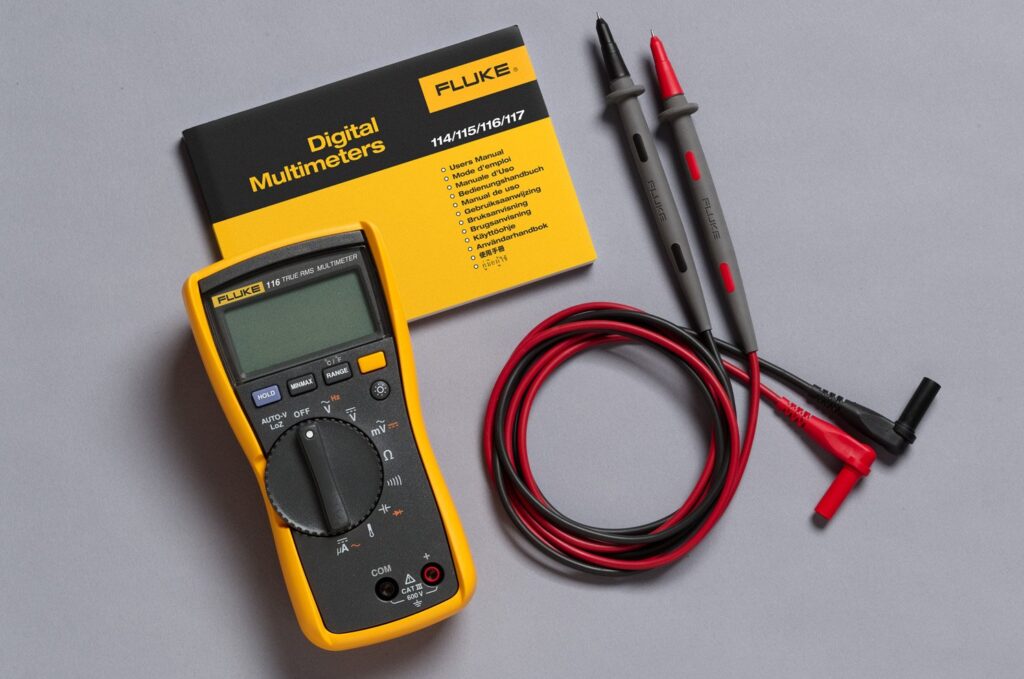
Frequency
This mode measures how many cycles per second (in Hertz) that a non-DC voltage is oscillating.
Frequency Range: 5 Hz to 50.00 kHz
Maximum Resolution: 0.01 Hz
Stated Accuracy: 0.1% + 2 counts
Theory: Frequency measurement is accomplished in multimeters by using an internal frequency counter, as well as a clean-up stage called a “comparator” to convert a smooth waveform (like a sine wave) into a clean rectangular wave for accurate measurement.
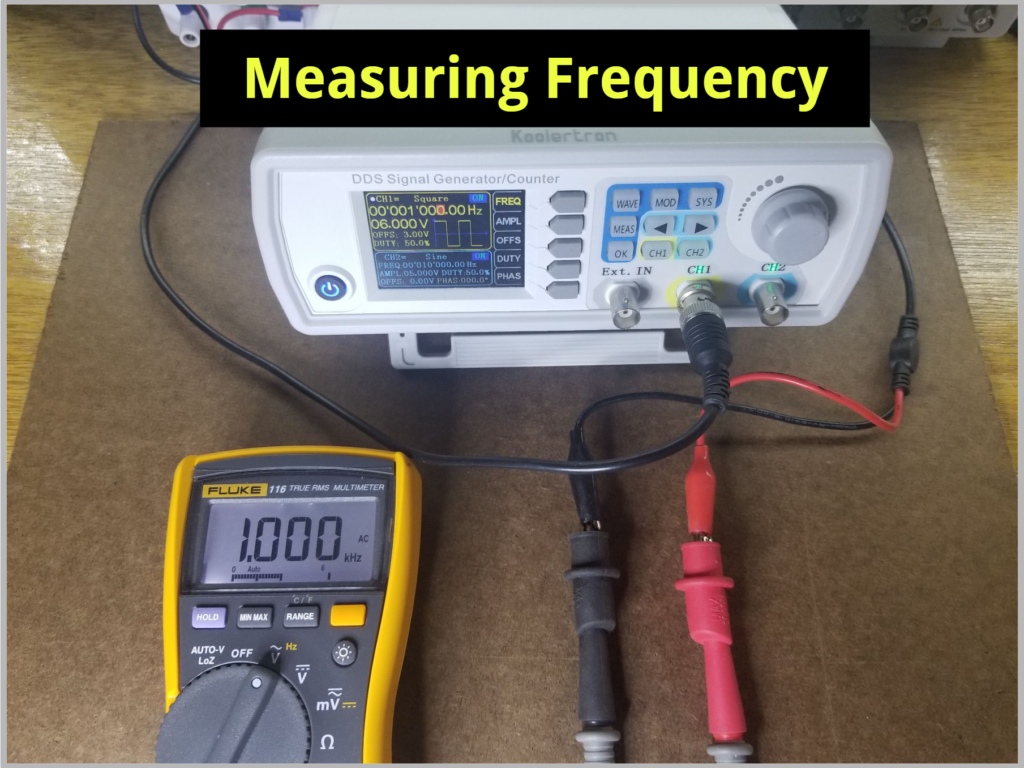
Resistance
Measuring resistance with this meter is self explanatory. It has a good range – measuring resistances all the way down to 0.1Ω up to 40MΩ.
Resistance Range: 0.1 Ω to 40 MΩ
Maximum Resolution: 0.1 Ω
Stated Accuracy: 0.9% + 2 counts, 0.9% (0.1 Ω – 600 Ω), 0.9% + 1 count, 0.9% (0.001 kΩ – 6 MΩ), 0.9% + 2 counts (0.01 MΩ – 40 MΩ).
Theory: Resistance is the opposition to current flow. It affects AC and DC circuits in the same way. Multimeters like the Fluke 116 inject a constant current through the device under test. That current, multiplied by the resistance equals a voltage that can be directly interpreted and displayed as a resistance value.
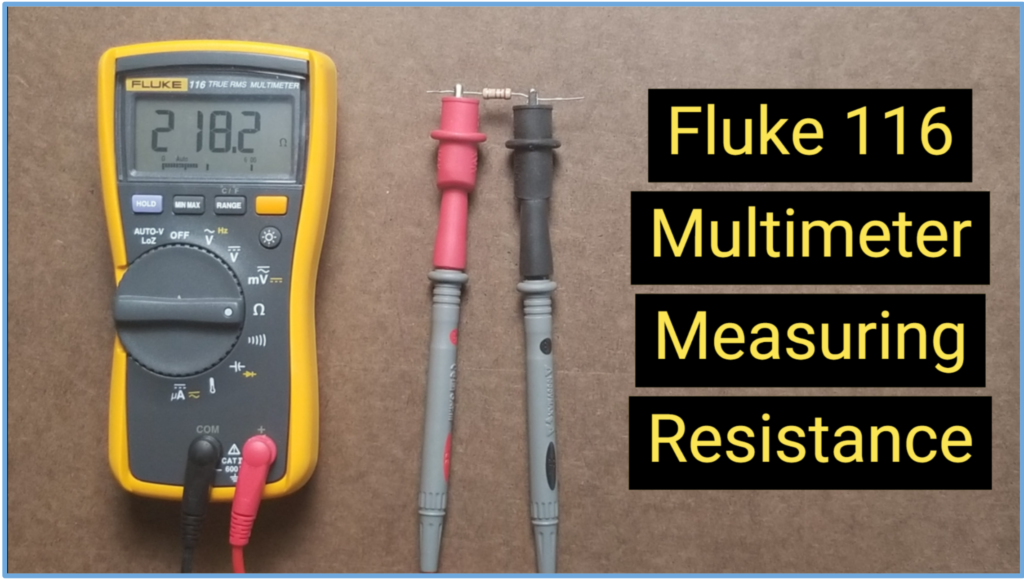
Continuity
Continuity give you an audible “beep” of resistances less than 65 Ω. Within this mode, the meter will still display resistances of up to 660 Ω but won’t beep. If you want to measure resistances greater than that, switch to the “resistance” function.
Note that Fluke specified a “cut in” resistance of 20 Ω and a cut out of 50 Ω , What I measured was a “cut in” of 65 Ω and a “cut out” of 140 Ω.
Diode Check
Theory: Diodes and other devices with semiconductor junctions (like those in transistors) pass current in only one direction, once their forward voltage drop is exceeded. In order to do this, you must have a voltage that is higher than that rated forward voltage. You must then have a current limiting resistor in series with that voltage in order to protect the device under test.
The DC voltage across the device under test is then measured and displayed. That is what makes up a diode and semiconductor test circuit inside of a multimeter. The Fluke 116 uses a 2.0V DC current limited voltage source, which is enough to forward bias most semiconductor junctions without damaging them. Thus any semiconductor junction which includes most diodes (except microwave diodes), most bipolar transistors, and even some LEDs that have a forward voltage drop of less than 2.0V DC can be tested. Zener diodes use a reverse voltage drop, and are not good candidates for the diode check unless their reverse voltage drop is less than 2.0V DC.
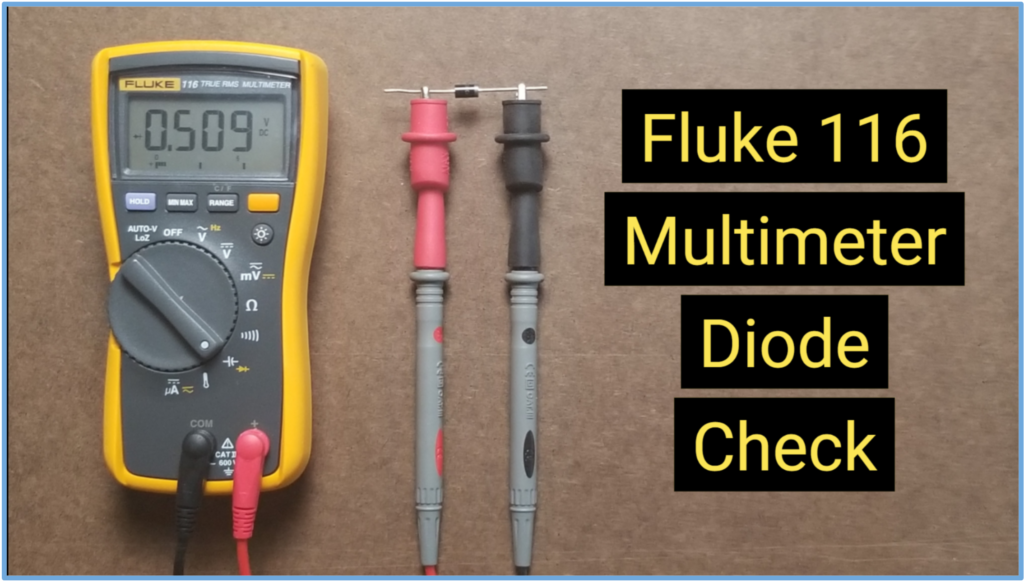
Capacitance
The capacitance mode is handy for measuring anything from 1nF (nanoFarad, or 1 billionth of a Farad) (small values found on circuit boards), up to 9999uF, which is larger than most anything you will find on appliances, HVAC systems, and most power supplies. It can measure all types of capacitors, including common electrolytics – but does not measure ESR (equivalent series resistance), which is another important metric of electrolytic capacitor health or failure.
The Fluke 116 can measure capacitance from 1nF to 9999uF.
Capacitance Range: 1uF to 9999uF
Maximum Resolution: 1nF
Stated Accuracy: 1.9% + 2 counts, 5% + 2 counts (> 1000uF)
Theory: Capacitance is measured by injecting a current source into the capacitor, and measuring the resulting voltage across it after a given amount of time. This measured voltage is converted by the meter’s algorithm, into a displayed capacitance value.
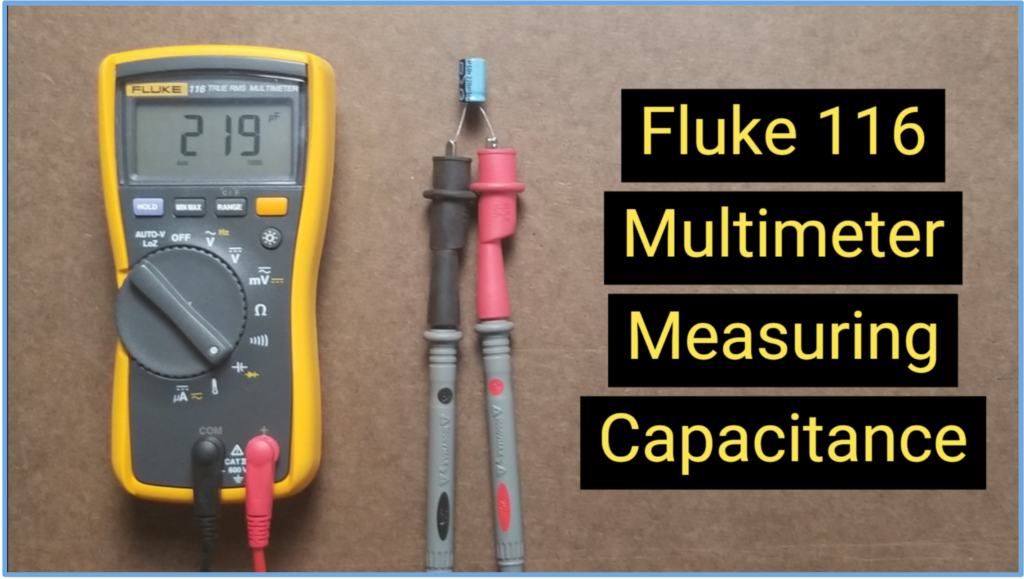
Temperature
The Fluke 116 multimeter measures temperature in both Fahrenheit (-40°F to 752°F) and Celsius (-40°C to 400°C) using a common K-type thermocouple and an adapter.
Temperature Range: -40C to 400C, -40F to 752F
Maximum Resolution: 0.1C, 0.2F
Stated Accuracy: 1% + 10C, 1% + 18F
Theory: A K-type thermocouple is a junction of two dissimilar metals that when heated, generate a voltage that is proportional to temperature.
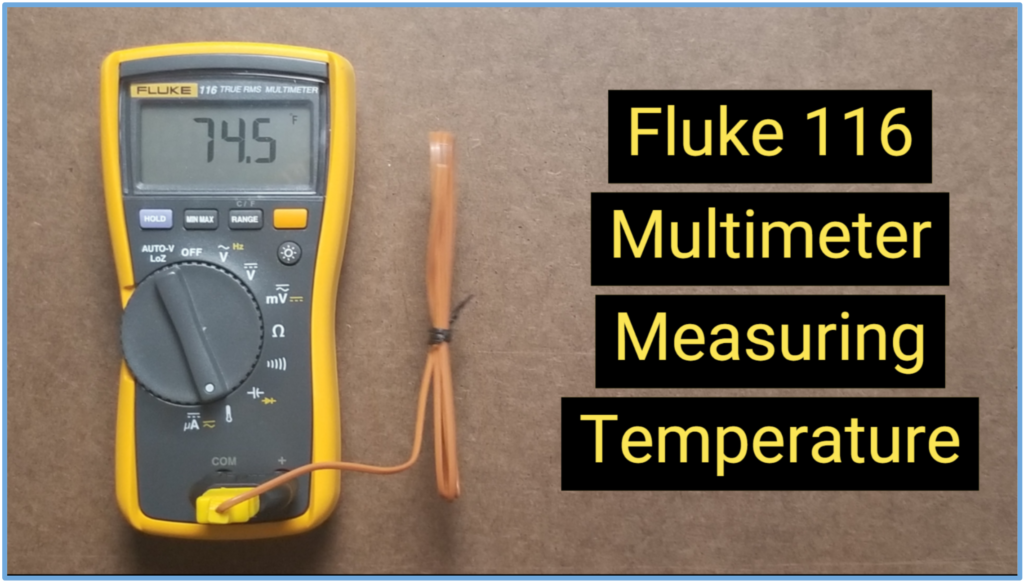
Click the Image Below to Purchase

Microamps – AC and DC
Current measurement with the Fluke 116 is done inline (the traditional way) and maxes out at 600uA. This range is oriented toward HVAC measurement of flame rectification. I don’t recommend that you use this function to test the flame rectification for gas cooktops or ovens that self-ignite with the same electrode that measures the flame rectification. Those sparks are at several thousand volts of potential, and can damage your meter.
Current Range: 0.1 to 600uA DC, 0.6 – 600uA AC
Maximum Resolution: 0.1 uA
Stated Accuracy: 1.5% + 3 counts AC, 2. 5% + 3counts AC (above 500Hz), 1% + 2 counts DC
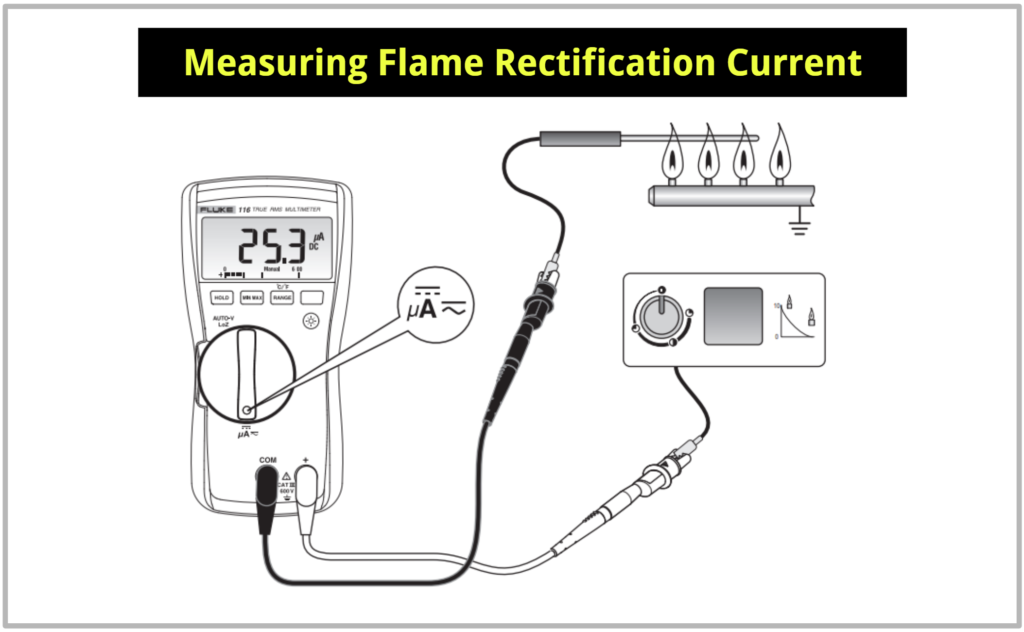
Backlight, Hold, Min/Max, and Range
Backlight
Press the “backlight” button for 40 seconds of backlighting.
Hold
Pressing the “hold” button locks the value on the display with its current value until you press it again – after which it resumes sampling.
Min/Max/Avg
To enter the Min/Max/Avg mode, press the “Min/Max” button during whatever measurement function you are currently performing. This mode allows you to step through “Min”, “Max”, and “Avg” functions so that you are measuring the minimum, maximum, and average values of an input respectively. Pressing the “Hold” button pauses these functions while maintaining the stored values. Through experimentation, I have found that the Min/Max function works for frequencies up to about 1Hz. So any values that change faster than one time per second may not be accurately recorded.
Range
The range button allows you to bypass the auto-range mode and stay within a specific measurement range. For example, if you are measuring DC volts and wanted to stay within the range for a 9V battery, you would press the “range” button until you reach the resolution you desired.
Pros and Cons
Pros (things I like)
I’ve owned other Fluke Multimeters, including a Fluke 11 that I used in a TV repair shop since the mid-1990s. It still works today. Any other multimeter I’ve owned didn’t last much more than 5 years without issues. So the quality is definitely there. The leads fit snugly. The selector switch is mechanically smooth, yet deliberate. The accuracy (both stated and realized) are impressive. The Fluke 116 sports many of the features needed for field technicians – such as for HVAC and appliance repair. Beyond the “normal” multimeter features, some of the functional aspects that stand out for me are the diode check, capacitance, and the LoZ function.
The diode check is a handy feature for testing semiconductors. It provides a acknowledging “beep” for readings likely in a forward-bias region, and a continuous beep for readings likely to be a short or near-short. The most-useful audio feedback is something that is lacking in the competing Klein CL800.
The capacitance function is very handy, and quite accurate. This function is well utilized for HVAC and Appliance Technicians.
The LoZ function is one of the most handy features of the Fluke 116 multimeter. It can detect ghost voltages, compromised voltage sources, and voltage resulting from leakage current. It puts a load on a circuit that will shut down low capacity voltage sources, giving you a better understanding of a voltage’s legitimacy or integrity. It apparently uses a thermistor to establish the low 3.2kΩ (initial) input impedance, which quickly increases in value as it heat up – reducing it’s wattage (heat) output, and keeping it from overheating the meter.
Cons (things I don’t like)
As a multimeter targeted toward field technicians, it does lack some very desirable functions that are frequently needed in the field. For one, it has no way to measure current above 600 microamps. The current measurement function provided by the meter narrow in its usage scope as it is specific to flame rectification. Although very useful for the HVAC technician, there are a plethora of cases where current measurement is necessary while in the field. Traditionally, current measurement has been “in-line”, where the meter is actually placed in the circuit by tapping in. Because that is inconvenient, clamp-meters were invented long ago, that are minimally invasive. They still require being clamped around a single conductor, but in most cases, that is readily doable. The Fluke 116 simply isn’t characterized as a clamp-meter, so I won’t criticize it for that. It does, however, necessitate purchasing a separate clamp accessory for purpose – which can be expensive. So it’s innate lack of practical current measuring capability is a negative for me.
Being a true RMS meter, it is designed to manage irregular waveform shapes, in addition to sinusoidal ones. It seemed to do well with square waves in that respect, but like all multimeters I tested, didn’t do so well with full wave or half wave rectified sinusoidal. These you will encounter in power supplies and with refrigerator inlet valves to name a few instances. Where my trusty oscilloscope came close the the “calculated” values, the Fluke 116 (and every other multimeter I tested) read only 50% of the calculated value of a full wave and 75% of a half-wave rectified sinusoid.
The diode check is a handy function for testing semiconductors. As noted, the bias voltage is a current-limited approximate 2.5VDC but overloads at 2.0V. Thus any forward bias readings greater than 2.0V won’t be acknowledged. This is 33% less than the 3.0VDC that the competing meter Klein CL800 has – which is able to actually test high-powered LEDs that need about that much voltage to forward bias. So I’d like to see more of a top-end range of 2.0V. From an engineering standpoint, it takes little effort to up that voltage by another 0.5V – 1.0V, in order to realize a big difference in utility.
Voltage ranges. Although the Fluke 116’s voltage range maxes out to a hefty 600V, and I really wouldn’t want to measure voltages that high anyway, competing models top out at 1000V. I doubt this is a tangible issue for most field technicians, but I did find it to be a bit annoying.
Summary
The Fluke 116 has many of the must have features for field technicians. Is of very good quality and accuracy. Like other Fluke meters I have owned over the years (and still work), it has the feel of durability and longevity. It checks most, but not all, of the functional boxes for HVAC and Appliance Repair disciplines.
There are other competing meters available though, that have a more comprehensive set of features, and frankly, check all of the boxes (except for maybe flame rectification current measurement).
So yes, you can get truly full-featured meters even at a lower cost than the Fluke 116 – which deems the Fluke 116’s significantly better quality and longevity, to be in my opinion, it’s primary differentiator. Although you can get more “bang for the buck” with competing multimeters like the Klein CL800, how many times will you have to replace those “other” meters before your Fluke breaks down.
Reviews such as this take many hours to perform. I hope this has been beneficial in not only helping you make a decision about whether to purchase the CL800, but with understanding how multimeters work in general. I do make a commission from any sales linked from this website and do appreciate your support.
CLICK HERE TO PURCHASE THE FLUKE MULTIMETER
Video Review of the Fluke 116 Multimeter
Below is a comprehensive video review of the Fluke 116 Multimeter
If this or any other article on this website has benefited you, please consider donating here:
To DONATE to the Tech Circuit – CLICK HERE
We are a participant in the Amazon Services LLC Associates Program, an affiliate advertising program designed to provide a means for us to earn fees by linking to Amazon.com and affiliated sites.
